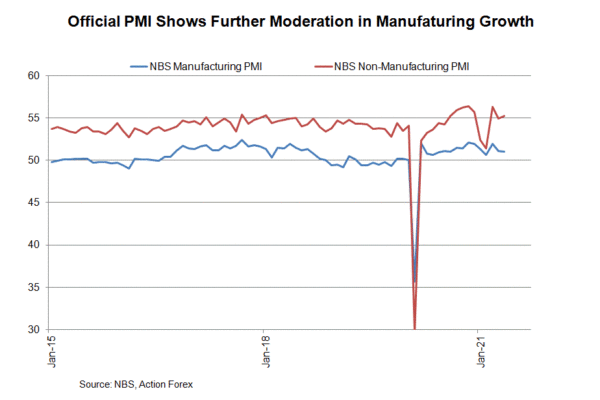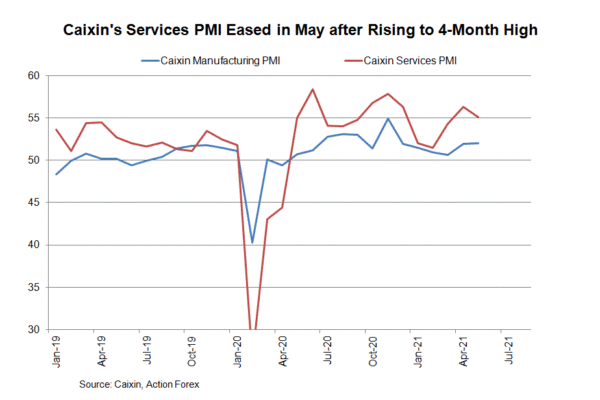The latest PMIs reveal that China’s economic activities eased in May. The Caixin services PMI eased to 55.1 in May from 56.3 a month ago, while the manufacturing PMI increased marginally, by -0.1 point, to 52.The detailed report suggests that new business slowed which price pressures intensified. The situation applies not only to the services sector, but also to the manufacturing and construction sectors.

New Orders
Looking into details of the Caixin services report, the “new business” index slipped -1 point to 54.7 in May while the “new export business” index declined to 49.7 (reading below 50 represents contraction) from April’s 53.2. Moderating business activities dragged employment.
The official PMI report released earlier this week confirmed a similar trend in large corporations. The NBS manufacturing slipped -0.1 point to 51 in May, while the non-manufacturing PMI (services and construction) climbed higher to 55.2 from 54.9 in April. Looking into the sub-indices, “new orders” dropped -0.7 point to 51.3 while “new export order” declined -2.1 points to 48.3, lowest since June last year, in May.
We believe Chinese exports were affected by resurgence in coronavirus cases in some countries. Meanwhile, strength in renminbi as diminished competitive of Chinese goods and services. In light of this, the government has announced measures to curb appreciation of its currency
Price Pressure
Price pressures have increased in both upstream and downstream sectors. The “input prices” index increased +2.1 points to 56.6 in May as costs of raw materials, energy, staff and transport increased. The “output prices” index climbed +0.4 point higher to 52.9. Companies have to absorb some of the increase in costs despite the attempt to pass them to customers. The situation is more severe in the manufacturing sector. The “input price” index gained +2.2 points to 64.4 in May. This marks the highest level since December 2016. The “output price” index also soared +4.5 points to60.7, a level not seen since February 2011.
NBS’ official report also pointed to rapidly accelerating price pressures in manufacturing activities. The “input cost” index jumped to 72.8, highest since November 2010, in May. The reading was 66.9 in April. The “output prices” index also soared to a record high of 60.6.
Employment Situation
The employment situation weakened slightly in different sectors, in both large companies and SMEs. The Caixin services “employment” index slipped mildly, by -0.2 ppt, to 52.5 in May, while that for the manufacturing sector fell to 50.1 from 50.7. In the NBS report, the “employment” index slipped -0.7 point to 48.9 in May. We believe some companies turned cautious in hiring due to higher input costs and decelerating growth in business activities.
Outlook
Concerning the economic outlook, the Caixin “business expectation” index slipped -1.5 points to 64.4 in May. While the reading remained strong and continued to point to further expansion in business activities, companies noted “concerns over how long the global economy will take to recover from the pandemic”.











